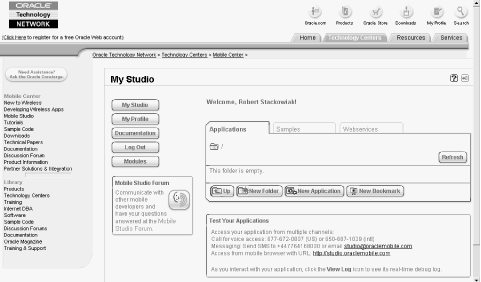14.2 OracleAS Wireless Development
| OracleAS Wireless applications can be developed in a completely custom fashion or you can leverage prebuilt applications that are provided with OracleAS Wireless. Markup languages supported for mobile applications include the following:
The OracleAS Wireless engine provides translation to the appropriate device markup language.
When developing an OracleAS Wireless application, you typically follow these general steps:
14.2.1 OracleAS Wireless Development ToolsThe primary tools available for OracleAS Wireless development are Oracle JDeveloper, the Wireless Development Kit, and My Studio. 14.2.1.1 Oracle JDeveloperOracle JDeveloper (packaged in the Oracle Developer Suite) is the primary tool used to build OracleAS Wireless applications. The GUI-based JDeveloper Wireless Extension (JWE) enables you to create mobile applications through wizards and templates. You can use this tool to edit applications. Its device simulators also allow you to test applications and advanced systems and to view log files used in the debugging process. You can deploy applications from the JWE user interface. 14.2.1.2 OracleAS Wireless Development KitThe Wireless Development Kit can be used with Oracle JDeveloper, as well as with other development environments and device simulators. You can obtain the WDK at the Oracle Technology Network Wireless web site at http://otn.oracle.com/tech/wireless/index.html. The WDK includes the following:
Web Services components include a J2ME SDK and a J2ME Web Services Proxy Server. A small-footprint version of OracleAS Wireless Multi-Channel Server is provided in the WDK and enables the testing of wireless applications without requiring deployment of the full Oracle Application Server. The Multi-Channel Server is described in Section 14.3. The industrial-solution version of the WDK enables developers to build applications using XForms embedded within XHTML documents and then test them in a Telnet emulator. Figure 14-2 shows the home page for the Mobile area of the OTN, a free service for developers. The figure shows some of the mobile resources available through OTN. Figure 14-2. Oracle Technology Network Mobile web site 14.2.1.3 My StudioAfter you have created your application, you deploy it to a web server for voice or browser access, or for messaging. Applications can be deployed anywhere they are accessible from the Internet. The next step is to test your application. Oracle provides an online testing facility, the Oracle Mobile My Studio. You can obtain My Studio from http://studio.oraclemobile.com. This web site provides test facilities for voice, mobile browser, and two-way SMS. Real-time logs are generated as you test the applications that you view when debugging your application. When you come to the My Studio web site for the first time, you need to register on the Welcome page. Once you are a registered user, you can log in. You will then see tabs for Applications, Samples, and Webservices (see Figure 14-3). Exploring the My Studio tabs leads you to the following: Figure 14-3. Home page for My Studio online testing of OracleAS Wireless applications
My Studio includes online directions for how to test applications. Other online documentation provides help getting started, developing applications, and advanced topics related to voice, messaging, and J2ME Web Services. A link to the Mobile Studio Forum allows you to communicate with other OracleAS Wireless developers. 14.2.2 Prebuilt Wireless ApplicationsOracleAS Wireless provides a set of prebuilt applications that can be deployed on their own or that can serve as a starting point for building other applications. These applications are:
These applications are described in the following sections. OracleAS Wireless also provides the underlying infrastructure for mobile and voice access to Oracle's Collaboration Suite and E-Business Suite. 14.2.2.1 Mobile OfficeMobile Office provides wireless, voice, and messaging applications used to access common office productivity systems. Supported systems and interfaces include:
Published interfaces are available to extend the use of these applications to nonsupported systems. 14.2.2.2 Mobile MessagingMobile Messaging applications provide message exchange via email, SMS, MMS, voice, or fax. You can choose target destinations from address books or directory entries, or you can specify your own. Alerts and notifications can include email alerts, calendar appointment reminders and new appointments, and custom alerts using the Alert Service. 14.2.2.3 Mobile LocationMobile Location applications are location-aware and can be deployed via wireless, voice, or messaging interfaces. These applications can provide driving directions, find nearby businesses (along with directions to those businesses), and show locations on maps. |
EAN: 2147483647
Pages: 120
- Integration Strategies and Tactics for Information Technology Governance
- Linking the IT Balanced Scorecard to the Business Objectives at a Major Canadian Financial Group
- Measuring and Managing E-Business Initiatives Through the Balanced Scorecard
- Measuring ROI in E-Commerce Applications: Analysis to Action
- Technical Issues Related to IT Governance Tactics: Product Metrics, Measurements and Process Control
